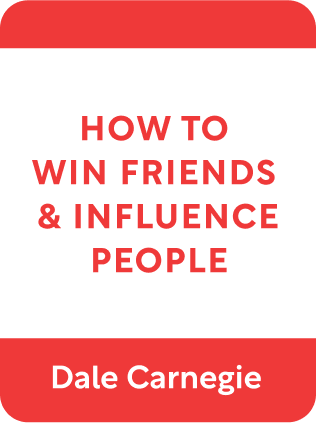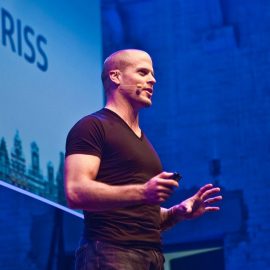

This article is an excerpt from the Shortform book guide to "How to Win Friends and Influence People" by Dale Carnegie. Shortform has the world's best summaries and analyses of books you should be reading.
Like this article? Sign up for a free trial here .
What are some How to Win Friends and Influence People examples that can help you learn the key principles? How can you use them in your life?
There are How to Win Friends and Influence People examples in every category, including how to make people like you and how to change someone’s mind.
Keep reading for the best How to Win Friends and Influence People examples.
How to Win Friends and Influence People Examples
These How to Win Friends and Influence People examples can explain how some of the basics of communication work.
Keep reading these How to Win Friends and Influence People examples on all aspects of the book.
Examples of Ways to Make People Like You
These How to Win Friends and Influence People examples are about how to make people like you—a huge part of the book’s philosophy.
- Show a genuine interest in the other person.
- Examples
- An editor said that he could tell after a few paragraphs if the author liked people. If the author doesn’t like people, people won’t like her stories.
- A famous magician didn’t see his audience as suckers. He was grateful they came to see him and endeavored to give them the very best he could. Before each show he repeated to himself, “I love my audience. I love my audience”
- It’s a common strategy for employers to ask front desk staff what they thought of applicants. Rude people are rejected.
- A banker interviewing a company president learned that the president’s grandson was collecting stamps. He dug up stamps his bank owned and offered them to the president, who was now much friendlier.
- A fuel vendor had tried to sell to a large chain store without success. Carnegie arranged a debate where they had to argue whether the chain store was better or worse for the country, and the vendor took the positive side. He approached the large chain manager asking for his help. The manager talked for two hours, proud of his company’s contributions to the world and even changed the vendor’s attitude. At the end, the chain store placed an order with the vendor.
2. A person’s name is to that person the sweetest and most important sound in any language.
- Examples
- Carnegie stories
- As a child, Carnegie had a large litter of rabbits. He promised that anyone who helped him pick clovers and feed would get a rabbit named after her.
- Later, Carnegie wanted the business of the Pennsylvania Railroad, run by Edgar Thomson, so he named the local steel mill “Edgar Thomson Steel Works.”
- He wanted to merge with the sleeping car company Pullman. When Carnegie mentioned the new company would be called Pullman still, Pullman became far more eager.
- Carnegie stories
3. Talk in terms of the other person’s interests.
- Examples
- Boy scout looking for funding who read about a president’s having a million dollar check bounce. He asked to see the check and wanted to boast to his friends that he had seen such a check.
- If you’re applying to a job where the founder has a drive for power or money, then talk about how you’ll help them gain more money. If they’re more of a missionary, then talk about how you will achieve their mission.
- When visiting an elderly aunt-in-law, a man admired the house and its craftsmanship. The aunt showed him around and explained all the memories, then desired to leave her deceased husband’s car with the man because of his appreciation of fine things.
Examples of Winning People to Your Way of Thinking
These How to Win Friends and Influence People examples are about getting people to see things the way you do.
1. The only way to get the best of an argument is to avoid it.
- Examples
- A tax consultant under audit felt the inspector had made a mistake. They were at loggerheads until the consultant admitted, “I’ve just had my knowledge in books. You have knowledge in real experience. Sometimes I wish I had a job like yours – I would learn a lot.” The inspector then talked for a long time about his work, and eventually cleared the consultant’s case.
2. Show respect for the other person’s opinions. Never say, ‘You’re Wrong.’ (Instead, admit that you might be the one who’s wrong.)
- Examples
- An engineering supervisor presented to management her new system of running yarn, highlighting how it was superior and how she had all the answers they needed. It failed – management wasn’t given a way to admit their current system’s failures and they became defensive. In the next session, she asked what their problems were and for their opinions on how to fix it. This paved the way for her solution.
- A lumber salesman was having his company’s pieces rejected by a quality inspector, who was unfamiliar with the white pine under concern. Instead of castigating the inspector for ignoring standard guidelines, the salesman asked questions about why each rejected piece was unsatisfactory, under the guise of figuring out how to deliver better shipments in the future. The inspector’s attitude changed, now being forced to consider the rejection criteria and realizing he didn’t have the full expertise to judge the pieces. The salesman insisted that while the pieces might be within standard code, if the inspector felt it was unsuitable, they would gladly have it rejected. The inspector began feeling guilty about rejecting any piece, and ultimately realized their company was at fault for not having specified the correct quality grade.
3. Begin in a friendly way.
- Examples
- Rockefeller had to deal with strikers who hated him. He started by spending weeks with the strikers and their families. Then he gave a speech that glowed with friendliness:
- “This is a red-letter day in my life. It is the first time I have ever had the good fortune to meet the representatives of the employees of this great company…I am proud to be here, and I shall remember this gathering as long as I live. Had this meeting been held two weeks ago, I should have stood here a stranger to most of you, recognizing a few faces. Having had the opportunity last week of visiting all the camps in the southern coal field and of talking individually with practically all of the representatives; having visited in your homes, met many of your wives and children, we meet here not as stranger, but as friends, and it is in that spirit of mutual friendship that I am glad to have this opportunity to discuss with you our common interests…It is only by your courtesy that I am here.”
- The president of a motor company was friendly to strikers – publishing an ad complimenting the strikers on their peacefulness. He bought them baseball bats and gloves and invited them to play on lots. This begot friendliness – the strikers in turn cleaned up the factory of their own will.
- Someone had a tough landlord who increased his rent. Instead of complaining about how this was unfair, he talked about how much he appreciated the house and the way the landlord ran the building, and how he would like to stay another year but couldn’t afford it.
- Rockefeller had to deal with strikers who hated him. He started by spending weeks with the strikers and their families. Then he gave a speech that glowed with friendliness:
Examples of Changing People’s Minds
These How to Win Friends and Influence People examples are about how to change someone’s mind.
1. Begin with praise and honest appreciation.
- Examples
- A subcontractor was delaying on parts. A manager from the construction company visited the president. First the manager pointed out that he had a distinctive name, the only one in Brooklyn. Then he commended him on the cleanliness of the factory. On a tour, he complimented the president on specific machines the president had designed. At the end of lunch, the president said he knew why the manager was here and said the parts would be shipped on time, even if they had to delay the other parts.
2. Call attention to people’s mistakes indirectly.
- Examples
- Speechwriter for McKinley wrote a mediocre speech. McKinley: “That is a splendid speech. There are many occasions on which it would be the right thing to say, but is it quite suitable to this particular occasion?”
- Charles Schwab saw workers in a mill smoking under a “No Smoking” sign. Instead of chastising them, he handed each of them a cigar, asking “I’ll appreciate it, boys, if you will smoke these on the outside.”
- John Wanamaker saw a customer being ignored at the sales counter while the salespeople were chatting in the corner. He serviced the woman himself, then handed the purchase to the salespeople to be wrapped.
- A eulogy writer passed the sermon by his wife. Finding it dull, she said, “that would make an excellent article for the North American Review.”
- [If done poorly, this can be taken as passive-aggressive – a back-handed compliment – so it’s not my usual approach. The middle ground is probably ]
- [I admit I haven’t reconciled some of Dale Carnegie’s principles with Ray Dalio’s principles of radical transparency. There is probably a healthy medium here, to express your viewpoint without being an asshole about it.]
3. Make the other person happy about doing the thing you suggest.
- Examples
- When President Wilson appointed one diplomat over another to Europe to discuss WWI, the appointed diplomat broke the news: “It would be unwise for anyone to do this officially, and your going would attract a great deal of attention and people would wonder why you were there.”
These are just a few examples from the book. See the book our the full summary for more.

———End of Preview———
Like what you just read? Read the rest of the world's best book summary and analysis of Dale Carnegie's "How to Win Friends and Influence People" at Shortform .
Here's what you'll find in our full How to Win Friends and Influence People summary :
- The 6 ways to make people like you
- How you can give feedback to others and improve their behavior
- An essential checklist for handling arguments in a productive way






